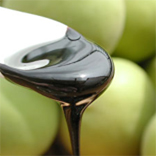Health Info
Psyllium (Dietary Fiber)
Psyllium (Dietary Fiber)
 Psyllium is natural vegetable gum collected from outer seed covering of Plantago Ovata Forskal produced in India. It is comprised of more than 90% dietary fiber, and contains insoluble and water-soluble fiber. Effects are said to include water absorption, expansion, adsorption, regulation of intestinal function, control of blood sugar levels, and adjustment of serum fat.
Psyllium is natural vegetable gum collected from outer seed covering of Plantago Ovata Forskal produced in India. It is comprised of more than 90% dietary fiber, and contains insoluble and water-soluble fiber. Effects are said to include water absorption, expansion, adsorption, regulation of intestinal function, control of blood sugar levels, and adjustment of serum fat.
In traditional Indian medicine (Ayurveda), Psyllium has been used to treat obesity and high cholesterol since the 10th Century. Even in modern medicine, soluble fiber included in psyllium is widely recognized as effective for civilization disease (obesity, high blood pressure, arteriosclerosis, diabetes) caused by high fat / highly purified food. In Germany, it is used to improve chronic constipation and irritable bowel syndrome (IBS), and reduce pain related to hemorrhoids and during bowel movement, and to prevent constipation in pregnant women.
In Japan, foods for specified health use which contain psyllium-derived dietary fiber have been approved in recent years, and have attracted attention as diet material which “helps lose weight naturally without rebounding, and which is good for one’s health.”
-
01Diet and anti-obesity
Psyllium is not digested, and does not become fermented, even by gut bacteria. Actual calorie count is zero. It absorbs moisture and swells in the intestine (60-80ml/g), easing the sense of hunger. It also is effective to control fat absorption.
-
02Intestinal regulation
Swollen psyllium stimulates intestinal peristaltic action. It also promotes excretion of harmful material and cleans the inside the digestive tract, reducing the risk of various diseases.
-
03Reduction of cholesterol
The main reason why psyllium reduces serum cholesterol is that catabolism of cholesterol in the liver into bile acid is accelerated, as excretion of bile acid is promoted (hinders enterohepatic circulation). Total cholesterol is reduced, but HDL-cholesterol (good cholesterol) is not greatly affected.
-
04Controls rising blood sugar
Psyllium delays sugar absorption, controlling rising blood sugar after a meal.
| Soluble Fiber | Insoluble Fiber |
|---|---|
| Soluble fiber dissolves and thickens in water | Insoluble fiber does not dissolve in water |
| It binds with cholesterol and bile acids in the small intestine and eliminates them from the body. It also slows the absorption of carbohydrates and reducing the rise of blood sugar after a meal. →Lowering cholesterol →Helping prevent diabetes |
It absorbs water as it passes through the body. (water-retaining capacity 50 -100ml /g) →Preventing overeating →Adding bulk to the stool and speeds up transit time preventing constipation |
Plum Extract
 Plum extract is made by pressing and boiling green plums and obtaining their concentrated extract. Only 30-40g are obtained from 1kg of plums- the active ingredients in plums are highly concentrated.
Plum extract is made by pressing and boiling green plums and obtaining their concentrated extract. Only 30-40g are obtained from 1kg of plums- the active ingredients in plums are highly concentrated.
Plum extract is effective to improve blood circulation, provides anti-hypertensive activity, activates immune cells, promotes anti-influenza virus activity, quickens recovery from fatigue, and strengthens the liver and bacteriostatic action. It contains many organic acids, including citric acid as a main component (giving it a very acidic taste), as well as many minerals such as phosphorus, iron, calcium, and magnesium.
In addition, a specific and precious component of plum extract is “mumefural”, which is not found in raw green plums and pickled plums, and is considered effective for improving blood circulation.
Reference: Rapid / quantitative assessment of Food Functionality by MC-FAN, Blood rheology measurement device
(URL http://www.naro.affrc.go.jp/project/results/laboratory/nfri/1998/nfri98-01.html )
Lactoferrin
-
01Lactoferrin is a protein contained in milk which is important for biological defense
Lactoferrin is found in many mammals. It is a kind of protein contained in high concentration in human breast milk, especially colostrum which is secreted in large amounts several days after birth. In addition to breast milk, lactoferrin exists in exocrine secretions of the body, such as saliva, tear drops, nasal discharge, and mucosal fluids, and neutrophils, a type of white blood cell, and is thought to be a protective factor preventing bacterial and viral attacks from the outside. Furthermore, it has attracted attention as a protein with various roles related to health maintenance.
-
02Where does the name “Lactoferrin” come from?
Lactoferrin was named after the ferrin=protein that binds with iron in lacto=milk.
Lactoferrin has very strong affinity to bind with iron, and is known to control the growth of microorganisms. -
03How much Lactoferrin is contained in milk?
100ml of human colostrum (breast milk up to 5th day of birth) contains approx.600mg lactoferrin. 100ml of normal milk (breast milk 3 weeks after birth) contains approx.200mg. Human colostrum contains approx. 10 times more lactoferrin than cow’s milk.
-
04Lactoferrin controls bad bacteria, and helps good bacteria
Pathogens and putrefying bacteria such as e-coli, staphylococci, and Helicobacter pylori requires iron to multiply. Lactoferrin deprives bad bacteria of iron, controlling its growth. On the other hand, lactoferrin promotes the growth of bifidobacteria which is a good bacteria and is known to regulate intestinal function.
-
05I recently heard about enteric-coated lactoferrin pills. Can lactoferrin be delivered to the intestines as is?
Orally taken lactoferrin is dissolved and delivered to the intestines as lactoferrin itself, or as a peptide or as lactoferricin. Lactoferricin is a peptide created by lactoferrin which is dissolved by pepsine, a digestive enzyme in the stomach. Lactoferricin’s antibiotic action is more than 10 times stronger than original lactoferrin.
-
06Lactoferricin, a resolvent of Lactoferrin
While lactoferricin attacks bad bacteria such as E-coli, Staphylococcus aureus, and clostridia, it has almost no effect on bifidobacteria, a good bacteria. Lactoferricin shows bactericidal activity for E. coli bacteria O-157, methicillin-resistant Staphylococcus aureus (MRSA), Helicobacter pylori which causes gastritis, gastric ulcer and stomach cancer.
In addition to this strong antibacterial activity, Lactoferricin shows equal or stronger physiological performance than the original lactoferrin, such as antioxidant activity, immunoregulatory properties, and an inhibitory effect on cancer cells.Lactoferricin and other Lactoferrin-derived peptides, as well as the original lactoferrin, are thought to cooperatively perform various beneficial activities in the stomach and intestines. Hence, lactoferrin’s basic functions may not be realized unless it is digested in the stomach.
FK-23 (Patented Component)
The heat processed FK-23 fungus body has an immune activity that is three times better than in its raw state, and exhibits excellent absorbability in the living body. FK-23 acts on immune cells in the body.
LFK (Patented Component)
Faecalis FK-23 fungus extract is obtained by enzymatically dissolving selected FK-23 fungus and extracting its active ingredient. LFK is more easily absorbed by this special process, and aids in health maintenance faster than by ingesting normal raw faecalis fungus.